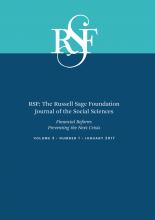Research Article
Open Access
Strategic Agent-Based Modeling of Financial Markets
Michael P. Wellman, Elaine Wah
RSF: The Russell Sage Foundation Journal of the Social Sciences January 2017, 3 (1) 104-119; DOI: https://doi.org/10.7758/RSF.2017.3.1.06
Michael P. Wellman
aLynn A. Conway Collegiate Professor of Computer Science and Engineering at the University of Michigan
Elaine Wah
bWorks at IEX Group Inc. This work was completed while she was a research assistant at the University of Michigan

REFERENCES
- ↵Arnuk, Sal, and Joseph Saluzzi. 2012. Broken Markets: How High Frequency Trading and Predatory Practices on Wall Street Are Destroying Investor Confidence and Your Portfolio. Upper Saddle River, N.J.: FT Press.
- ↵Arthur, Brian, John H. Holland, Blake LeBaron, Richard Palmer, and Paul Tayler. 1997. “Asset Pricing Under Endogenous Expectations in an Artificial Stock Market.” In The Economy as an Evolving Complex System II, edited by Brian W. Arthur, Steven N. Durlauf, and David A. Lane. Boulder: Westview Press.
- ↵Beeson, Ed. 2015. “SEC Fines Direct Edge $14M over Misleading Order Types.” Law360 (online journal), January 12, 2015. Available at: http://www.law360.com/articles/610484/sec-fines-direct-edge-14m-over-misleading-order-types; accessed June 12, 2016.
- ↵
- Bessembinder, Hendrik
- ↵Bessembinder, Hendrik, and Kumar Venkataraman. 2010. “Bid-Ask Spreads: Measuring Trade Execution Costs in Financial Markets.” In Encyclopedia of Quantitative Finance, edited by Rama Cont. New York: John Wiley.
- ↵Bodek, Haim. 2013. The Problem of HFT: Collected Writings on High Frequency Trading and Stock Market Structure Reform. Electronic edition. CreateSpace Independent Publishing Platform.
- ↵Bookstaber, Richard. 2012. “Using Agent-Based Models for Analyzing Threats to Financial Stability.” Office of Financial Research Working Paper 3. Washington: U.S. Department of the Treasury.
- ↵
- Boswijk, H. Peter,
- Cars H. Hommes, , and
- Sebastiano Manzan
- ↵
- ↵
- Cardella, Laura,
- Jia Hao, ,
- Ivalina Kalcheva, , and
- Yung-Yu Ma
- ↵Das, Rajarshi, James E. Hanson, Jeffrey O. Kephart, and Gerald Tesauro. 2001. “Agent-Human Interactions in the Continuous Double Auction.” Proceedings of the Seventeenth International Joint Conference on Artificial Intelligence. San Francisco: Morgan Kaufmann and American Association for Artificial Intelligence.
- ↵
- Easley, David,
- Marcos M. López de Prado, , and
- Maureen O’Hara
- ↵
- Fricke, Daniel, and
- Thomas Lux
- ↵Friedman, Daniel. 1993. “The Double Auction Market Institution: A Survey.” In The Double Auction Market: Institutions, Theories, and Evidence, edited by Daniel Friedman and John Rust. Reading, Mass.: Addison-Wesley.
- ↵Gintis, Herbert. 2000. Game Theory Evolving. Princeton, N.J.: Princeton University Press.
- ↵
- Gode, Dhananjay K., and
- Shyam Sunder
- ↵
- Goettler, Ronald L.,
- Christine A. Parlour, , and
- Uday Rajan
- ↵
- Goettler, Ronald L,
- Christine A. Parlour, , and
- Uday Rajan
- ↵
- Hendershott, Terrence,
- Charles M. Jones, , and
- Albert J. Menkveld
- ↵Jones, Charles M. 2013. “What Do We Know About High Frequency Trading?” Available at SSRN (link for download): http://ssrn.com/abstract=2236201; accessed June 12, 2016.
- ↵Kirilenko, Andrei A., Albert S. Kyle, Mehrdad Samadi, and Tugkan Tuzun. 2014. “The Flash Crash: The Impact of High Frequency Trading on an Electronic Market.” Available at SSRN (link for download): http://ssrn.com/abstract=1686004; accessed June 12, 2016.
- ↵
- LeBaron, Blake
- ↵
- Lee, Bernard,
- Shih-fen Cheng, , and
- Annie Koh
- ↵
- ↵Lewis, Michael. 2014. Flash Boys: A Wall Street Revolt. New York: W. W. Norton.
- ↵Madhavan, Ananth, Kewei Ming, Vesna Straser, and Yingchuan Wang. 2002. “How Effective Are Effective Spreads? An Evaluation of Trade Side Classification Algorithms.” Working paper. ITG Analytic Incubator, November 20. Available at: http://analyticsincubator.itginc.com/library/papers/how-effective-are-effective-spreads-an-evaluation-of-trade-side-classification-algorithms/; accessed June 12, 2016.
- ↵
- Menkveld, Albert J
- ↵Paddrik, Mark, Roy Hayes, Jr., Andrew Todd, Steve Yang, Peter Beling, and William Scherer. 2012. “An Agent-Based Model of the E-Mini S&P 500 Applied to Flash Crash Analysis.” Conference on Computational Intelligence for Financial Engineering and Economics, New York (March 29).
- ↵
- Piwowar, Michael S., and
- Li Wei
- ↵
- Subrahmanyam, Avanidhar
- ↵Tesfatsion, Leigh. 2006. “Agent-Based Computational Economics: A Constructive Approach to Economic Theory.” In Handbook of Agent-Based Computational Economics, edited by Leigh Tesfatsion and Kenneth L. Judd. Amsterdam: Elsevier.
- ↵
- Vorobeychik, Yevgeniy,
- Michael P. Wellman, , and
- Satinder Singh
- ↵Wah, Elaine, Dylan R. Hurd, and Michael P. Wellman. 2015. “Strategic Market Choice: Frequent Call Markets vs. Continuous Double Auctions for Fast and Slow Traders.” Paper presented at Third EAI Conference on Auctions, Market Mechanisms, and Their Applications, Chicago (August 8 to 9). Available at: http://web.eecs.umich.edu/srg/?page_id=1666; accessed July 11, 2016.
- ↵Wah, Elaine, and Michael P. Wellman. 2013. “Latency Arbitrage, Market Fragmentation, and Efficiency: A Two-Market Model.” Proceedings of the Fourteenth ACM Conference on Electronic Commerce. Available at: http://dl.acm.org/citation.cfm?id=2482577, pp. 855–72; accessed July 11, 2016.
- ↵Wah, Elaine, and Michael P. Wellman. 2015. “Welfare Effects of Market Making in Continuous Double Auctions.” Proceedings of the Fourteenth International Conference on Autonomous Agents and Multiagent Systems. Available at: http://aamas2015.com/en/AAMAS_2015_USB/aamas/p57.pdf, pp. 57–66; accessed July 11, 2016
- ↵Wellman, Michael P. 2011. Trading Agents. Electronic edition. San Rafael, Calif.: Morgan & Claypool.
- ↵Wiedenbeck, Bryce, and Michael P. Wellman. 2012. “Scaling Simulation-Based Game Analysis Through Deviation-Preserving Reduction.” Proceedings of the Eleventh International Conference on Autonomous Agents and Multiagent Systems. Available at http://www.aamas-conference.org/Proceedings/aamas2012/papers/5E_1.pdf, pp. 931–38; accessed July 11, 2016.
In this issue
Strategic Agent-Based Modeling of Financial Markets
Michael P. Wellman, Elaine Wah
RSF: The Russell Sage Foundation Journal of the Social Sciences Jan 2017, 3 (1) 104-119; DOI: 10.7758/RSF.2017.3.1.06
Jump to section
Related Articles
- No related articles found.
Cited By...
- No citing articles found.





